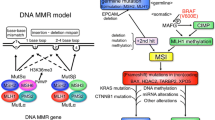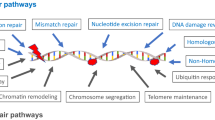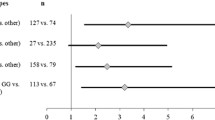Abstract
DNA repair defects might contribute both to cancer progression and to the extreme reactions to radiotherapy observed in ≈5% of patients. Polymorphic microsatellites in three DNA repair genes, XRCC1, XRCC3 and XRCC5, were analyzed for possible linkage to cancer status or clinical radiosensitivity. XRCC1, 3 and 5 proteins are involved in single-strand DNA break rejoining, recombinational repair, and double-strand DNA break rejoining respectively. Mendelianly inherited microsatellite polymorphisms in these genes were analyzed in three groups: volunteers with no cancer history; radiosensitive cancer patients; cancer patients with acceptable reactions to radiotherapy. Rare heterozygous alterations in all three gene regions were found solely in the cancer subpopulation. Association testing between these rare polymorphisms and cancer status revealed a significant association for XRCC1 (P=0.005), and XRCC3 (P=0.004). There was also an association between these polymorphisms and clinical radiosensitivity for XRCC1 (P=0.03), and XRCC3 (P=0.005).
Similar content being viewed by others
Literature Cited
Liu, B., Parsons, R., Papadopoulos, N., Nicolaides, N.C., Lynch, H.T., Watson, P., Jass, J.R., Dunlop, M., Wyllie, A., Peltomaki, P., de la Chapelle, A., Hamilton, S.R., Vogelstein, B., and Kinzler, K.W. (1996) Analysis of musmatch repair genes in hereditary non-polyposis colorectal cancer patients.Nat Med.,2:169–174.
Badie, C., Iliakis, G., Foray, N., Alsbeith, G., Pantellias, G.E., Okayasu, R., Cheong, N., Russell, N.S., Begg, A.C., Arlett, C.F., and Malaise, E.P. (1995) Defective repair of DNA double-strand breaks and chromosome damage in fibroblasts from a radiosensitive leukaemia patient.Cancer Res.,55:1232–1234.
Thompson, L.H., Brookman, K.W., Jones, N.J., Allen, S.A., and Carrano, A.V. (1990) Molecular cloning of the human XRCC1 gene which corrects defective DNA strand break repair and sister chromatid exchange.Mol. Cell. Biol.,10:6160–6171.
Caldecott, K.W., Aoufouchi, S., Johnson, P., and Shall, S. (1996) XRCC1 polypeptide interacts with DNA polymerase beta and possibly poly (ADP-ribose) polymerase, and DNA ligase III is a novel molecular ‘nick-sensor’ in vitro.Nucleic Acids Res.,24:4387–4394.
Tebbs, R.S., Zhao, Y., Tucker, J.D., Scheerer, J.B., Siciliano, M.J., Hwang, M., Liu, N., Legerski, R.J., and Thompson, L.H. (1995) Correction of chromosomal instability and sensitivity to diverse mutagens by a cloned cDNA of the XRCC3 DNA repair gene.Proc. Natl. Acad. Sci. U.S.A. 92:6354–6358.
Thompson, L.H. (1996) Evidence that mammalian cells possess homologous recombinational repair pathways.Mutat Res.,363:77–88.
Chen, F.Q., Peterson, S.R., Story, M.D., and Chen, D.J. (1996) Disruption of DNA-PK in Ku80 mutant xrs-6 and the implications in DNA double-strand break repair.Mutat. Res.,362:9–19.
Hafezparast, M., Kaur, G.P., Zdzienicka, M., Athwal, R.S., Lehmann, A.R., and Jeggo, P.A. (1993) Subchromosomal localization of a gene (XRCC5) involved in double strand break repair to the region 2q34-36.Somat. Cell. Mol. Genet.,19:413–421.
Taccioli, G.E., Gottlieb, T.M., Blunt, T., Priestley, A., Demengeot, J., Mizuta, R., Lehmann, A.R., Alt, F.W., Jackson, S.P., and Jeggo, P.A. (1994) Ku80: product of the XRCC5 gene and its role in DNA repair and V(D)J recombination.Science,265:1442–1445.
Lees-Miller, S.P., Chen, Y.R., and Anderson, C.W. (1990) Human cells contain a DNA-activated protein kinase that phosphorylates simian virus 40 T antigen. mouse p53, and the human Ku autoantigen.Mol. Cell. Biol.,10:6472–6481.
Weissenbach, J., Gyapay, G., Dib, C., Vignal, A., Morissette, J., Millasseau, P., Vaysseix, G., and Lathrop, M. (1992) A second-generation linkage map of the human genome.Nature,359:794–801.
Mahadevan, M., Tsilfidis, C., Sabourin, L., Shutler, G., Amemiya, C., Jansen, G., Neville, C., Narang, M., Barcelo, J., Ohoy, K., Leblond, S., Earlemacdonald J., Dejong, P.J., Wieringa, B., and Korneluk, R.G. (1992) Myotonic dystrophy mutation: an unstable CTG repeat in the 3′ untranslated region of the gene.Science,255:1253–1255.
Huntington’s Disease Collaborative Research Group. (1993). A novel gene containing a trinucleotide repeat that is expanded and unstable on Huntington’s disease chromosomes.Cell,72:971–983.
Fu, Y.H., Kuhl, D., Pizzuti, A., Pieretti, M., Sutcliffe, J.S., Richards, S., Verkerk, A., Holden, J., Fenwick, R.G., Warren, S.T., Oostra, B.A., Nelson, D.L., and Caskey, C.T. (1991). Variation of the CGG repeat at the fragile X site results in genetic instability: resolution of the Sherman paradox.Cell,67:1047–1058.
Bates, G. (1996). Expanded glutamines and neurodegeneration—a gain of insight.Bioessays,18:175–178.
Leach, F.S., Nicolaides, N.C., Papadopoulos, N., Liu, B., Jen, J., Parsons, R., Peltomaki, P., Sistonen, P., Aaltonen, L.A., Nystromlahti, M., Guan, X.Y., Zhang, J., Meltzer, P.S., Yu, J.W., Kao, F.T., Chen, D.J., Cerosaletti, K.M., Fournier, R., Todd, S., Lewis, T., Leach, R.J., Naylor, S.L., Weissenbach, J., Mecklin, J.P., Jarvinen, H., Petersen, G.M., Hamilton, S.R., Green, J., Jass, J., Watson, P., Lynch, H.T., Trent, J.M., Delachapelle, A., Kinzler, K.W., and Vogelstein, B. (1993) Mutations of a mutS homolog in hereditary nonpolyposis colorectal cancer.Cell,75:1215–1225.
Fishel, R., Lescoe, M.K., Rao, M., Copeland, N.G., Jenkins, N.A., Garber, J., Kane, M., and Kolodner, R. (1993) The human mutator gene homolog MSH2 and its association with hereditary nonpolyposis colon cancer.Cell,75:1027–1038.
Ellis, N.A., Groden, J., Ye, T.Z., Straughen, J., Lennon, D.J., Ciocci, S., Proytcheva, M., and German, J. (1995) The Bloom’s syndrome gene product is homologous to RecQ helicases.Cell,83:655–666.
Kaneko, H., Inoue, R., Yamada, Y., Sukegawa, K., Fukao, T., Tashita, H., Teramoto, T., Kasahara, K., Takami, T., and Kondo, N. (1996) Microsatellite instability in B-cell lymphoma originating from Bloom syndrome.Int. J. Cancer,69:480–483.
Hayashi, K. (1991) PCR-SSCP: A simple and sensitive method for detection of mutations in the genomic DNA.PCR Methods Applic.,1:34–38.
Thompson, L.H., Brookman, K.W., Dillehay, L.E., Carrano, A.V., Mazrimas, J.A., Mooney, C.L., and Minkler, J.L. (1982) A CHO cell strain having hypersensitivity to mutagens, a defect in DNA strand-break repair, and an extraordinary baseline frequency of sister chromatid exchange.Mutat. Res.,95:427–440.
Taccioli, G.E., Rathbun, G., Oltz, E., Stamato, T., Jeggo, P.A., and Alt, F.W. (1993) Impairment of V(D) J recombination in double strand-break repair mutants.Science,260:207–210.
Peterson, S.R., Kurimasa, A., Oshimura, M., Dynan, W.S., Bradbury, E.M., and Chen, D.J. (1995) Loss of the catalytic subunit of the DNA-dependent protein kinase in DNA double-strand-break-repair mutant mammalian cells.Proc. Natl. Acad. Sci. U.S.A.,92:3171–3174.
Schuler, W., Weiler, I.J., Schuler, A., Phillips, R.A., Rosenberg, N., Mak, T.W., Kearney, J.F., Perry, R.P., and Bosma, M.J. (1986) Rearrangement of antigen receptor genes is defective in mice with severe combined immune-defective in mice with severe combined immune-deficiency.Cell,46:963–972.
Cavazzana-Calvo, M., Le Deist, F., De Saint Basil, G., Papadopoulo, D., De Villartay, J.P., and Fischer, A. (1993) Increased radiosensitivity of granulocyte macrophage colony forming units and skin fibroblasts in human autosomal recessive severe combined immuno-deficiency.J. Clin. Invest.,91:1214–1218.
West, C.M.L., Hendry, J.H., Scott, D., Davidson, S.E., and Hunter, R.D. (1991) 25th Paterson Symposium—is there a future for radiosensitivity testing?.Br. J. Cancer,64:197–199.
Kagan, A.R. (1988) The importance of genetics for the optimization of radiation therapy.Am. J. Clin. Oncol.,11:84–88.
Lawton, P., and Lambin, P. (1994) Radiosensitivity testing of normal tissues: a way to optimize radio-therapy?Eur. J. Cancer,30A:576–577.
Author information
Authors and Affiliations
Rights and permissions
About this article
Cite this article
Price, E.A., Bourne, S.L., Radbourne, R. et al. Rare microsatellite polymorphisms in the DNA repair genesXRCC1, XRCC3 andXRCC5 associated with cancer in patients of varying radiosensitivity. Somat Cell Mol Genet 23, 237–247 (1997). https://doi.org/10.1007/BF02674415
Received:
Accepted:
Issue Date:
DOI: https://doi.org/10.1007/BF02674415




